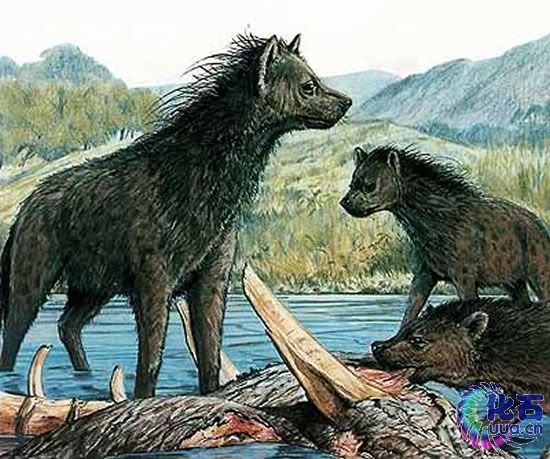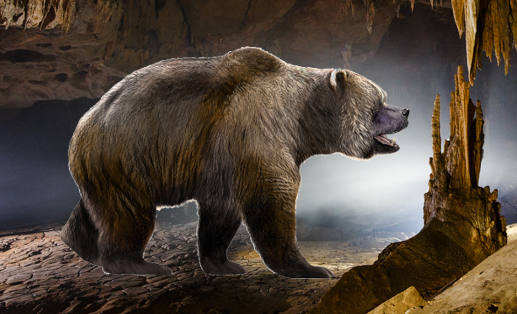Post by dinosauria101 on May 7, 2019 20:36:45 GMT 5
Cave Hyena (clan of 5) - Crocuta crocuta spelaea
The cave hyena (Crocuta crocuta spelaea), also known as the Ice Age spotted hyena, was a paleosubspecies of spotted hyena which ranged from the Iberian Peninsula to eastern Siberia. It is one of the best known mammals of the Ice Age and is well represented in many European bone caves. The cave hyena was a highly specialised animal, with its progressive and regressive features being more developed than in its modern African relative. It preyed on large mammals (primarily wild horses, steppe bison and woolly rhinoceros), and was responsible for the accumulation of hundreds of large Pleistocene mammal bones in areas including horizontal caves, sinkholes, mud pits and muddy areas along rivers. The cause of the cave hyena's extinction is not fully understood, though it could have been due to a combination of factors, including climate change and competition with other predators. The European cave hyena was much larger than its modern African cousin, having been estimated to weigh 88 kg (194 lb).

European Cave Bear - Ursus spelaeus
The cave bear (Ursus spelaeus) was a species of bear that lived in Europe during the Pleistocene and became extinct at the beginning of the Last Glacial Maximum about 27,500 years ago. Both the name cave and the scientific name spelaeus derive from the fact that fossils of this species were mostly found in caves, indicating that this species spent more time in caves than the brown bear, which only uses caves for hibernation. Consequently, in the course of time, whole layers of bones, almost entire skeletons, were found in many caves. The cave bear had a very broad, domed skull with a steep forehead. Its stout body had long thighs, massive shins and in-turning feet, making it similar in skeletal structure to the brown bear. Cave bears were comparable in size to the largest modern day bears. The average weight for males was 400–500 kilograms (880–1102 pounds), while females weighed 225–250 kg (496–551 lbs). Of cave bear skeletons in museums, 90% are male due to a misconception that the female skeletons were merely "dwarfs". Cave bears grew larger during glaciations and smaller during interglacials, probably to adjust heat loss rate. Cave bears of the last ice age lacked the usual 2–3 premolars present in other bears; to compensate, the last molar is very elongated, with supplementary cusps. The humerus of the cave bear was similar in size to that of the polar bear, as were the femora of females. The femora of male cave bears, however, bore more similarities in size to those of Kodiak bears.

Credit to Wikipedia
The cave hyena (Crocuta crocuta spelaea), also known as the Ice Age spotted hyena, was a paleosubspecies of spotted hyena which ranged from the Iberian Peninsula to eastern Siberia. It is one of the best known mammals of the Ice Age and is well represented in many European bone caves. The cave hyena was a highly specialised animal, with its progressive and regressive features being more developed than in its modern African relative. It preyed on large mammals (primarily wild horses, steppe bison and woolly rhinoceros), and was responsible for the accumulation of hundreds of large Pleistocene mammal bones in areas including horizontal caves, sinkholes, mud pits and muddy areas along rivers. The cause of the cave hyena's extinction is not fully understood, though it could have been due to a combination of factors, including climate change and competition with other predators. The European cave hyena was much larger than its modern African cousin, having been estimated to weigh 88 kg (194 lb).

European Cave Bear - Ursus spelaeus
The cave bear (Ursus spelaeus) was a species of bear that lived in Europe during the Pleistocene and became extinct at the beginning of the Last Glacial Maximum about 27,500 years ago. Both the name cave and the scientific name spelaeus derive from the fact that fossils of this species were mostly found in caves, indicating that this species spent more time in caves than the brown bear, which only uses caves for hibernation. Consequently, in the course of time, whole layers of bones, almost entire skeletons, were found in many caves. The cave bear had a very broad, domed skull with a steep forehead. Its stout body had long thighs, massive shins and in-turning feet, making it similar in skeletal structure to the brown bear. Cave bears were comparable in size to the largest modern day bears. The average weight for males was 400–500 kilograms (880–1102 pounds), while females weighed 225–250 kg (496–551 lbs). Of cave bear skeletons in museums, 90% are male due to a misconception that the female skeletons were merely "dwarfs". Cave bears grew larger during glaciations and smaller during interglacials, probably to adjust heat loss rate. Cave bears of the last ice age lacked the usual 2–3 premolars present in other bears; to compensate, the last molar is very elongated, with supplementary cusps. The humerus of the cave bear was similar in size to that of the polar bear, as were the femora of females. The femora of male cave bears, however, bore more similarities in size to those of Kodiak bears.

Credit to Wikipedia




